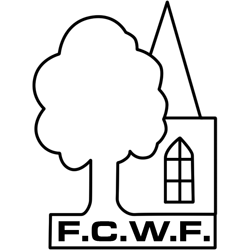This page is a catalogue of the slime moulds that have been found in Childwall Woods and Fields
Slime moulds are a group of organisms that can live freely as a single cell but come together to form larger structures to reproduce. They come in many shapes and sizes and are easily mistaken for fungi.
Spring is always a wonderful time to find slime moulds. It’s not quite warm enough for fungi but the rainy nature of this season makes it perfect for slime moulds.
You can see them on wet rotting wood throughout Childwall Woods, but you would be mistaken in thinking they were taking nutrients from the wood. They are hunting and devouring bacteria and fungi that are living in the wood.
Here are a few to look out for.
Wolf’s Milk Slime Mould (Lycogala epidendrum)
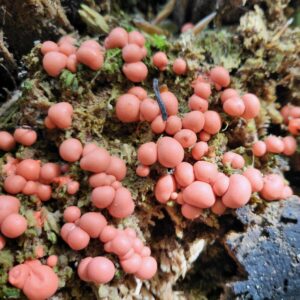
Lycogala epidendrum. In its reproductive stage.
These bright pink bobbles on the rotting log are the result of the single cells of the slime mould, coming together to form spores. These pink balls will turn brown over a few days as they turn to powdery spores which blow away in the wind.
False Puffball, (Enteridium lycoperdon)
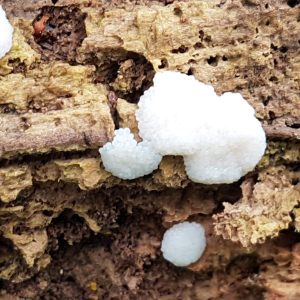
A newly formed False Puffball
You may see this shiny greyish-white swelling on dead wood throughout Childwall Woods during the cooler part of April. This is the reproductive stage of the slime mould.
During its feeding stage, amoeba-type cells feed on bacteria, fungi, yeasts and microorganisms on a decaying stump or branch. Finally, when they have eaten all they can, they merge and change into a swollen growth similar to a cauliflower floret shown above.
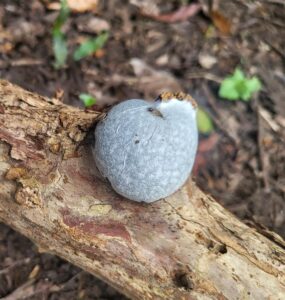
This becomes a shiny dry crust very quickly and crumbles away within a day or two revealing the brown dust-like spores underneath. These are dispersed by wind and rain to find new sites to colonise.
Called a false puffball because it looks so similar to the fungi puffball.
Stemonitopsis
This is the reproductive stage of the Stemonitopsis group of slime moulds that come together in wet weather to form these tiny lollipop shapes on stalks which will dry and blow away as spores. The ‘seeds’ of the slime mould.
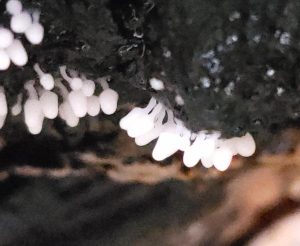
This tiny group, no bigger than a hand, were tucked underneath the long fallen tree by the end of the carriageway in Childwall Woods, where they began as single cells consuming microorganisms until they were ready to join together for reproduction.
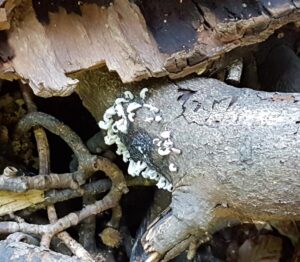
Slime mould on a rotting log
The cooler spell at the end of summer sometimes triggers the slime moulds to go into their reproductive stage and these little white curls on the old log pile are one of the Steminitus group and deserve a closer look.
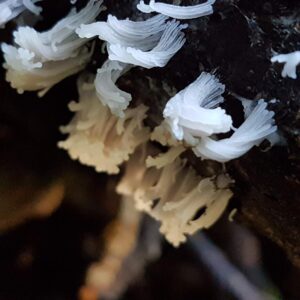
The immature tubes, still white until they mature. Notice the thin stalk on each one.
The long tube-like strands will turn to brown dust after the new spores have developed.
But describing this beautiful living organism cannot do it justice. Click here to watch Stemonitis pulsate and bloom.
Stemonitopsis Typhina
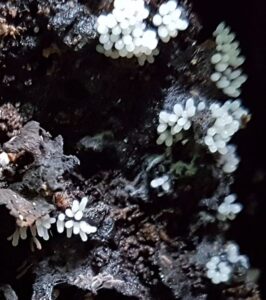
Stemonitopsis Typhina
Here is evidence of another slime mould in the Stemonitus Family. Spores released from these go on to produce new amoeba when they land on damp wood. We certainly have enough of that in Childwall Woods.
Carnival Candy Slime Mould (Arcyria denudata)
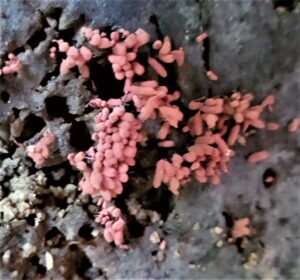
Carnival Candy Slime Mould does not pretend to be anything but a slime mould. A beautiful fluffy pink one.
When compatible Amoeba meet and combine, a fruiting body is formed. These fruiting bodies each resemble a tiny candy floss.
For more information on Slime Moulds visit Warwick University School of Life Sciences for a wonderful explanation.
The Carnival Candy Slime Moulds turn brown with age, releasing their spores into the air.
Yellow Carnival Candy Slime Mould, Arcyria obvelata
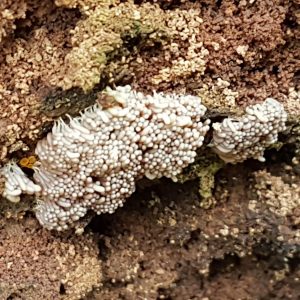
There are 900 different species of slime mould which makes it difficult to be accurate with identification. This one is probably the lighter form of the Carnival Candy Slime Mould. This will develop quickly into fluffy heads similar to candy floss which will blow away as spores, similar to its relative above.
Tapioca Slime Mould, Brefeldia maxima
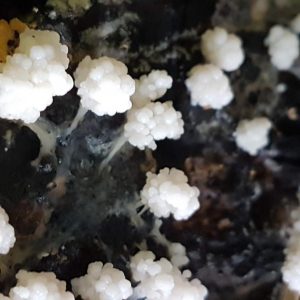
Tapioca Slime Mould
This slime mould gets its name from its resemblance to the milky white desert it resembles.
Within days these tiny white balloon structures that are slightly bigger than a pinhead will join together and form a crust until the spores underneath are ready to be released, then it will crumble to nothing.
If you look closely at dead bark after the rain, you may see this or other similar slime moulds during spring.
Dog Vomit Slime Mould, Fuligo septica.
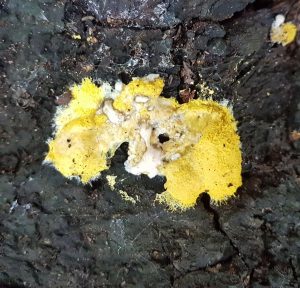
Dog vomit slime mould decorating a veteran tree after heavy rain.
This attractively named slime mould is often seen on the bark of trees during August after heavy rain.
If you look closely at the edges of the mould you will see tiny hair-like feelers reaching out as it very slowly moves across the bark locating a source of food.
This specimen is past its prime and will soon turn to dust-like spores and disperse in the wind to colonise another tree when the conditions are right. But they may not hatch right away. Slime Mould spores can lie dormant for years until conditions are just right.
Honeycomb Coral Slime Mould (Ceratiomyxa fruticulosa)
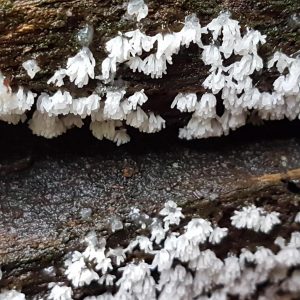
This slime mould is regularly found on rotting wood and doesn’t seem to mind the season.
This delicate slime mould is made up of bunches of tiny white tubes. It can be seen on the underside of rotting branches out of the sunlight, and if you look very closely you will see it is growing in the broken-down structure of the wood. It is however not responsible for the rot, just taking advantage of it to find microorganisms and fungi to devour.
Unlike the slime moulds shown earlier, these tubes do not grow out on tiny stalks but grow in bunches almost like tiny flowers.
Physarum bitectum – A plasmodial slime mould
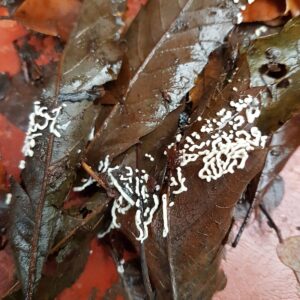
A rare find. This slime mould is at the protozoa stage where single cells come together to form the blobs and lines you see above. They creep along the surface of damp wood or leaves digesting microorganisms that they encounter. They then harden into the lines you see on the leaves above. that draw a map of their activity.
If you spot a slime mould in Childwall Woods take a photo and let me know.
bcfcwf@gmail.com
Brenda Cameron
All photographs are the author’s own.
If you like what you see on this page, why not join the Friends of Childwall Woods and Fields here?
Everything on this page has been identified as accurately as possible however with so many species existing, errors are inevitable.
12/1/2024

